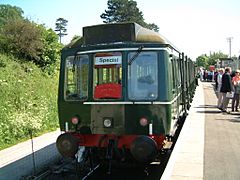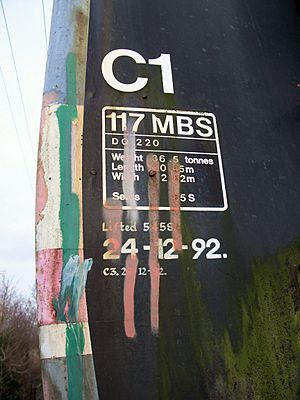British Rail Class 117 facts for kids
Quick facts for kids British Rail Class 117 |
|
|---|---|

51402 at Northampton & Lamport Railway. This vehicle, along with 51367 has since moved to the Strathspey Railway.
|
|
| In service | 1961-1999 |
| Manufacturer | Pressed Steel |
| Number built | 168 |
| Number in service | 0 |
| Number preserved | 66 |
| Number scrapped | 102 |
| Formation | DMBS/TCL/DMS |
| Fleet numbers | 51332-51373/59484-58522/51374-51415 |
| Capacity | 156 |
| Operator(s) | British Rail |
| Line(s) served | London Paddington station |
| Specifications | |
| Car length | 64 ft 0 in |
| Width | 9 ft 3 in |
| Height | 12 ft 8 1/2 in |
| Maximum speed | 70 mph (112 km/h) |
| Weight | 36 tons |
| Traction system | Mechanical |
| Prime mover(s) | BUT (AEC) 150hp then BUT (Leyland) 150hp |
| Safety system(s) | AWS |
| Multiple working | ■ Blue Square |
| Track gauge | 1,435 mm (4 ft 8 1⁄2 in) |

The British Rail Class 117 trains were a type of diesel multiple unit (DMU). A DMU is a train that has its own engine and can run by itself, without needing a separate locomotive. These trains were built by the Pressed Steel company between 1959 and 1960. They were an important part of Britain's railway system for many years.
Contents
What is a Class 117 Train?
The Class 117 trains were designed to carry passengers on local and suburban routes. They were known for being reliable and comfortable for their time. These trains helped connect many towns and cities across Britain.
Building and Design
Pressed Steel built a total of 168 of these train sets. Each set usually had three coaches.
- The first coach was a Driving Motor Brake Standard (DMBS). This coach had a driver's cab, an engine, and space for passengers.
- The middle coach was a Trailer Composite Lavatory (TCL). This coach did not have an engine or a driver's cab. It had both first-class and standard-class seats, plus a toilet.
- The last coach was a Driving Motor Standard (DMS). This coach also had a driver's cab and an engine, but only standard-class seats.
Key Features of the Trains
These trains were quite long, about 64 feet (19.5 meters) per coach. They could reach a top speed of 70 miles per hour (112 km/h). Each three-coach train could carry up to 156 passengers. They used powerful diesel engines to move along the tracks.
Where Did They Run?
The Class 117 trains were mainly used by British Rail. They served many different lines across the country. One of their main routes was from London Paddington station. They were a common sight on commuter lines around London and other major cities.
Years of Service
These trains started carrying passengers in 1961. They continued to be in service for a long time, finally retiring from British Rail in 1999. This means they served for almost 40 years! After their main service, some were bought by other railway companies or preserved.
Life After British Rail
Even after they stopped running for British Rail, many Class 117 trains found new homes.
- Some were sold to smaller, private railway companies.
- Others were bought by heritage railways. These are special railways that keep old trains running for people to enjoy.
- Out of the 168 trains built, 66 have been saved and preserved. This means you can still see some of them running today on heritage lines.
Images for kids





